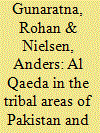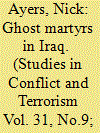|
|
|
Sort Order |
|
|
|
Items / Page
|
|
|
|
|
|
|
| Srl | Item |
| 1 |
ID:
083668


|
|
|
|
|
| Publication |
2008.
|
| Summary/Abstract |
After the U.S. led coalition forces attacked Al Qaeda and Taliban infrastructure in Afghanistan beginning in October 2001, the epicenter of global terrorism moved from Afghanistan to tribal Pakistan. Known as the Federally Administered Tribal Area (FATA) in Pakistan, this region has emerged as the premier hunting ground for the Al Qaeda leadership. With the co-option of new groups in FATA and its adjacent North Western Frontier Province (NWFP), the Al Qaeda threat has proliferated. The threat posed by the Afghan Taliban has been compounded with the addition of a new range of actors notably the Pakistani Taliban. Working together with multiple threat groups, both foreign and Pakistani, Al Qaeda directs its global jihad campaign from FATA. Unless the terrorist enclave is cleared on the Afghan-Pakistan border, the threat to Afghanistan and mainland Pakistan will continue. This article seeks to map the evolution of Al Qaeda and its associated groups since their relocation to FATA.
|
|
|
|
|
|
|
|
|
|
|
|
|
|
|
|
| 2 |
ID:
083669


|
|
|
|
|
| Publication |
2008.
|
| Summary/Abstract |
This article examines the manifestation of jihadist ideology in the strategic thought and behavior of war-fighting forces. Employing the "strategic approach," it aims to determine whether jihadist ideology is a military asset or a strategic disadvantage for armed forces. It hypothesizes the impact of jihadist ideology on the use of force by examining its potential effects in seven strategic aspects: vision, threat perception, objectives, strategy, constituency, legitimacy, and conduct. It concludes by discussing the contradictory effects of jihadist ideology on the utility of force. Theoretical arguments throughout the article are elaborated by a discussion of jihadist forces in the Bosnian civil war
|
|
|
|
|
|
|
|
|
|
|
|
|
|
|
|
| 3 |
ID:
083671


|
|
|
|
|
| Publication |
2008.
|
| Summary/Abstract |
Scholars have developed several rationalist explanations for the use of suicide attacks by terrorist organizations. Using evidence from Palestine, Israel, Lebanon, Sri Lanka, Chechnya, and Turkey, these authors have created plausible and rational models for attacks, which many consider to be "irrational." Although the conflict in Iraq has, by most accounts, experienced more suicide bombings than any other struggle, its contemporary nature has made research and analysis on the subject difficult. This article analyzes four of these models and their implications with respect to the events in Iraq. Although the evidence is not conclusive, the data suggests that organizations are not using suicide attacks to (1) gain nationalist objectives, (2) signal strength to a foreign government, or (3)"outbid" rival organizations, as many scholars suggest. Instead, the evidence suggests that these attacks are used for (1) tactical advantages and (2) to aid the global recruiting effort of Al Qaeda-linked organizations.
|
|
|
|
|
|
|
|
|
|
|
|
|
|
|
|
| 4 |
ID:
083670


|
|
|
|
|
| Publication |
2008.
|
| Summary/Abstract |
The article explores the development of Islamic radicalism in East Africa by examining specific states. The author argues that the evidence suggests that although Islamic radicalism has not made substantial inroads into the region, it may still do so, as East Africa suffers from political repression as well as socioeconomic problems. The author concludes that the region must undergo significant changes to improve political representation and socioeconomic conditions.
|
|
|
|
|
|
|
|
|
|
|
|
|
|
|
|
|
|
|
|
|